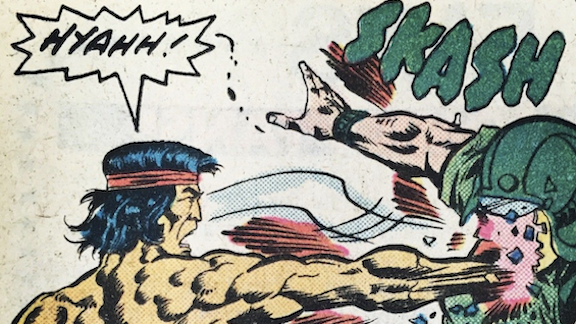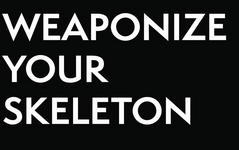Roadblocks, Plateaus, & Epiphanies
In thinking about how it felt to learn and process the tool of violence for my own use, I realized there were five distinct phases in the evolution of my thinking and, by extension, my training focus. As my understanding grew, the way I trained changed. Or, I should say, as my understanding became more simplified and streamlined, so did the way I trained.
Phase 1: Approaching the material from a fantasy angle
I originally came from a martial arts background, and so approached the new material as merely a “super-rugged” martial art. Or all martial arts crammed into one. We all bring our own appetite to the table; an all-in-one approach is what I was seeking on my martial arts vision quest because that is what I’d been led to believe was required when someone wants to kill you.
I was also well “informed” by the mass media. I was sure that the real deal would go down like the climax of a Schwarzenegger film. I was looking to square off and trade blows until I could pull out a really cool technique and impale my foe on a protruding fuel rod from a nuclear reactor. And then coolly declaim a pithy one-liner. Really.
I wanted to train for a duel, and was acutely interested in countering whatever it was he had in store for me while being able to get inside. What exactly would happen in there I had no real idea. But I did have the fantasies.
My mat time reflected my thinking; I wanted to look cool with all kinds of whippy-spinny crap. I went fast and slapped my reaction partners around. I probably wasn’t a lot of fun to work with. (Sorry, Joe!)
Phase 2: A more realistic angle, but not quite
I realized that movies and comic books were crap when it comes to useful instruction in violence—they require violence to be dramatic and climactic for effect. Real violence, in contrast, was often ugly, brutish, and short.
All that realization did for me was to make me aware of my own insufficiencies; it made me overly troubled by what the other person was up to. I sought to prepare for all contingencies. I worked over scenario after scenario in my head, trying vainly to cover every possible “what if”.
I sought ultimate, unassailable superiority as a palliative for my anxiety. I worked hard on “advanced” techniques, e.g., ever fancier joint breaks and throws.
Phase 3: Realizing he’s not my problem, I’m his problem
It’s great to say it—it’s another thing entirely to live it. I knew it was true, but I still wasn’t comfortable owning that ideal. I had a better grip on what was up, but I was still plagued by nagging concerns over what he might be up to. It was a lot of “Okay, I got that, but what if—”
This was the first time in my training where I began to concentrate on injuring him as a priority above and beyond what he was doing or what I thought would look cool. My mat time started to get ugly in the good way. (Sorry, Joe! But not really.)
Phase 4: Arriving at the singularity of violence
This is where it all came together. This is where I realized that all the seemingly disparate elements of violence were really just aspects of the same thing—every strike, joint break, and throw, with and without tools, were all one thing: injuring the person. This is where I made the shift from “fighting” into “injuring”. And it only took me 11 years!
This change came, to a large degree, from nine years of teaching. But it also came from anxiety fatigue. I was tired of worrying. I was tired of getting all tied up in knots over every little thing that might go wrong. The possibilities for fatal screwups were infinite; in the end it was just easier to let all of that go and focus on breaking the person. I realized I was my own worst enemy and decided to chuck it all and become the thing I feared most:
A person so narrowly dedicated to destruction that only death could stop me.
While dispatching the “bad guy” with flair and uncounterable aplomb is a nice idea, it’s nowhere near as good as beating the #%&! out of him. A solid, pedestrian game-ender to the groin is worth 10,000 of the fanciest techniques.
I began to own and live the truth that all targets are equal, as are all injuries; my workouts slowed and became inexorable. I simply took what I wanted. I laughed with unrestrained pleasure when people tried to grapple me, I taunted them openly as they tried to pin me, “Are you sure you got me?” Then I grabbed them by something unexpectedly fragile and dragged them screaming into my serial injury cave. Eyes and mouth wide, fingernails splintering on the stones as they vanished into darkness.
It was all about me all the time, and I was never sorry again.
Phase 5: Approaching the material from a sociopathic angle
The moral of the story? It’s not about what the #%&! he’s got or what the #%&! he wants to do—it’s about getting over there and beating the living #%&! out of him.
So what’s this mean for you?
It took me 11 years because there was no one there to tell me any different. We tell you how it goes down right now, we give you the tools to make it work and we show you how to swing those tools. You get the benefit of every last second we spent on the mats, every last second we spent thinking about it. Instead of making you relive every second we spent, we give you the end result. We’re here to tell you different.
So instead of reinventing the wheel, all you have to do is grab a body and hit the mats.
— Chris Ranck-Buhr (from 2006)
*I’m not sure why I chose to use grawlix instead of “fuck”—I’ve never shied away from expletives, especially such a venerable, storied, and versatile one. Maybe I just woke up soft that day.



Leave a Reply
Want to join the discussion?Feel free to contribute!